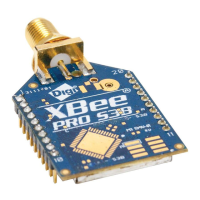XBee‐PRO®900HP/XBee‐PRO®XSCRFModules
©2014DigiInternationalInc. 105
In Sleep Mode, the module will not transmit or receive data until the module first transitions to Idle Mode. All
Sleep Modes are enabled and disabled using SM Command. Transitions into and out of Sleep Modes are
triggered by various events as shown in the table below.
SummaryofSleepModeConfigurations
Pin Sleep (SM = 1)
In order to achieve this state, SLEEP pin must be asserted (high). The module remains in Pin Sleep until the
SLEEP pin is de-asserted.
After enabling Pin Sleep, the SLEEP pin controls whether the XBee module is active or in Sleep Mode. When
SLEEP is de-asserted (low), the module is fully operational. When SLEEP is asserted (high), the module
transitions to Sleep Mode and remains in its lowest power-consuming state until the SLEEP pin is de-asserted.
SLEEP is only active if the module is setup to operate in this mode; otherwise the pin is ignored.
Once in Pin Sleep Mode, CTS
is de-asserted (high), indicating that data should not be sent to the module. The
PWR pin is also de-asserted (low) when the module is in Pin Sleep Mode.
Note: The SLEEP (pin9) cannot be asserted until after the transmission of the second byte has started.
Note: The module will complete a transmission or reception before activating Pin Sleep.
Cyclic Sleep (SM = 3-8)
Cyclic Sleep is the Sleep Mode in which the XBee module enters into a low-power state and awakens
periodically to determine if any transmissions are being sent.
When Cyclic Sleep settings are enabled, the XBee module goes into Sleep Mode after a user-defined period of
inactivity (no transmission or reception on the RF channel). The user-defined period is determined by ST
(Time before Sleep) Command.
While the module is in Cyclic Sleep Mode, CTS
is de-asserted (high) to indicate that data should not be sent to
the module during this time. When the module awakens to listen for data, CTS
is asserted and any data
received on the DI Pin is transmitted. The PWR pin is also de-asserted (low) when the module is in Cyclic
Sleep Mode.
The module remains in Sleep Mode for a user-defined period of time ranging from 0.5 seconds to 16 seconds
(SM Parameters 3 through 8). After this interval of time, the module returns to Idle Mode and listens for a
valid data packet for 100 ms. If the module does not detect valid data (on any frequency), the module returns
to Sleep Mode. If valid data is detected, the module transitions into Receive Mode and receives incoming RF
packets. The module then returns to Sleep Mode after a Period of inactivity that is determined by ST “Time
before Sleep” Command.
The module can also be configured to wake from cyclic sleep when SLEEP (pin 9) is de-asserted (low). To
configure a module to operate in this manner, PW (Pin Wake-up) Command must be issued. Once SLEEP is de-
asserted, the module is forced into Idle Mode and can begin transmitting or receiving data. It remains active
Sleep Mode
Setting
Transition into
Sleep Mode
Transition out of
Sleep Mode
Related
Commands
Typical Power
Consumption
(S3)
Typical Power
Consumption
(S3B)
Pin Sleep
(SM = 1)
Microcontroller can shut down and wake
modules by asserting (high) SLEEP (pin 9).
Note: The module will complete a
transmission or reception before activating
Pin Sleep.
De-assert (low)
SLEEP (pin 9).
SM 50 µA 2.5uA
Cyclic Sleep
(SM = 3-8)
Automatic transition to Sleep Mode occurs
in cycles as defined by the SM (Sleep
Mode) Command.
Note: The cyclic sleep time interval must be
shorter than the “Wake-up Initializer Timer”
(set by LH Command).
After the cyclic sleep
time interval elapses.
Note: Module can be
forced into Idle Mode
if PW (Pin Wake-up)
Command is enabled.
SM, ST, HT,
LH, PW
76 µA
when sleeping
2.5uA
when sleeping

